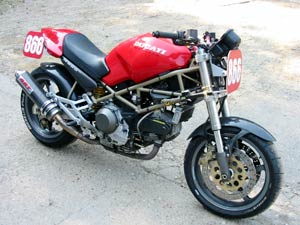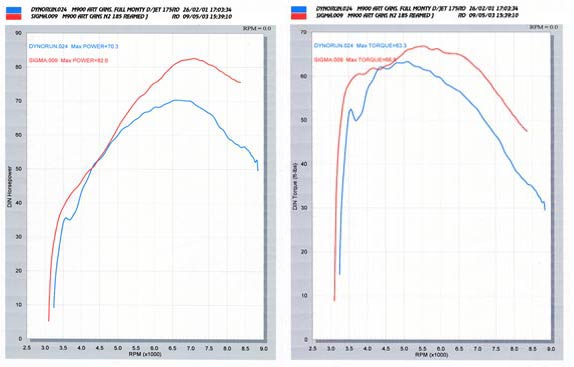|
 Well its taken a while but we have now had
one of our 2 valve motors in the right places for long enough to do the work and record the process at the dyno. Well its taken a while but we have now had
one of our 2 valve motors in the right places for long enough to do the work and record the process at the dyno.
The Ducati 900 2 valve motor has been around for ages, it has been described as the perfect motorcycle engine and indeed
for many purposes it is. Its fairly light, has a very good reliability record and provides a type of power that seems to have gone out of fashion in the UK. Torquey and lazy
it allows the rider to enjoy the ride. This is not a motor for rev happy wannabe racers, but in its way it is capable of devastatingly effective point-to-point performance on real roads and in real conditions.
This type of performance is best delivered with an engine with massive low down torque, the sort where your bike takes off immediately you
open the throttle and where the power keeps coming in a nice fluid, without any surprises sort of way. As ever if enough is good then more is better, Ducati have just shown this with their latest
1000cc variant of the motor. The engine has been used from 900 Supersports in the late nineties to the Mike Hailwood Evolution via a bunch of Monsters and an occasional Paris Dakar win in the
Cagiva Elephant of the early nineties.
In spec it has changed a bit over the years, but in a mostly rational evolutionary way. There have
been a couple of interesting derivatives, the water-cooled 907ie and ST2 motors but mainly the same stuff modified as knowledge increased.
Bore and stroke is 68mm x 92mm, valve angle is a fairly old fashioned 60 degrees. These figures
have remained the same since the first engines, logical derivatives of the 750 twin, rolled off the assembly line back in 1988. The 900 had a new 6 speed transmission and a dry clutch; shared with
the 4 valve Desmoquattro.
The engines are an interesting mix of technologies, the bottom end is derived directly from the
Pantah, head porting is the same on all the models and, with all due respect to the factory as bad as the 4 valve is good. It should not be a relatively easy proposition to beat a factory at its own
game, maybe there is some mystical or emissions related reason that I am not party to but there is no doubt that Ducati's 2 valve ports can be improved to a large degree, completely opposite to the 4 valvers!
Over the 15 years the engine has been around the spec has changed, mostly due to the different
uses to which it has been put, and during the last three years with a few really nice new components inside it has really delivered.
So what did they do? Well the first engines had heads facing the same direction, exhausts forward,
really good (it would seem) for exhaust cooling but a pain to get the carburettors and their associated airboxes in line for. This soon went as the priority moved to packaging and common
airboxes, it's true that the standard airbox is pretty inefficient too, but that may have a lot more to do with the available area on a normal bike for an airbox. It's taken a really unusual design like the
Multistrada to get the right volume onto a bike after all.
With the advent of the early nineties 900 SS models and the 906 the rear head was reversed to
allow one carburettor or fuel injection system to make the running in the centre of the vee. This lead to the 'normal ' 900ss engine we have seen for the last 14 years. The repositioning of the
carbs (or carb in the case of the 906 and its single dual choke weber) to the middle of the vee led to an acceptance of a too long inlet manifold, measuring almost 125mm (5 inches to those of you in
the colonies who hang onto imperial measurements!!). Something along the lines of 35mm was more in line with the engines needs, the effect on the power curve is to peak it early (and at a
higher number) but with a substantial reduction in powerband width.
There have been three cams designed for the engine, the original, which works well with the long
inlet lengths, as well as can be expected anyway. The ST2 cam and its derivative 900ie cam which is designed more for the short inlet lengths found on the fuel injected derivatives. In addition to the
three cams there has been only one set of valve sizes. As the spec has changed the bike has held on to its power better at high revs.
In the cooling department there has been a few more changes, oil/air cooling on the first bikes (oil
cooled barrels and air cooled heads), followed by the same castings being used for water cooling on the 907ie and ST2. The final versions of the engine, in completely the opposite way to intuitive
thought the engine became purely aircooled.
As with anything like this there is an exception to the rule, there were a group of bikes that came
with different valves cams and pistons. These exceptions were the 900 Monsters produced from mid 1997 to the advent of the 900ie motor in 2000. These bikes came with the complete cylinder head
from the 750 engine; smaller valves, ports and lower compression these bikes were at least 5bhp down on the original versions. These were also the motors supplied to Cagiva for the Gran Canyon
trailie. I have no idea why they were produced, it was clearly a retrograde step. I can only surmise that when TPG came in they found a large pile of 750 bits looking for a home and decided that they
should use them up somewhere harmless….
Enter Mick Dalley,
Mick races his Monster in hillclimbs and sprints, old fashioned English type hillclimbs where the hill
consists of a winding country road or the drive to the old manor house. For these hills power can help but the often slippery and rough tarmac needs supple suspension and an easy torquey power delivery.
Mick problem was that while he had correctly decided a 900 2 valve Monster would be quite an
effective tool for the job, he had unfortunately bought one of the '750 head' ones. We built the bike accurately, a full Monty build, then went off to the dyno, it was pretty obvious that we were not
going to get the horsepower levels we wanted without some major changes. This was going to be a pretty major test as the mods we had in mind would require a complete cylinder head rebuild.
It was obvious that if the problem was valve and cam related we would have to do something about it and fit new, better ones. Mick agreed and we set to work.
The spec was one we thought would provide the midrange pull and ease of control that Mick would
need on the hills, first up was a 944cc big bore kit, then standard 'proper' 900cc valves with the latest 900ie cams. Finally just to make sure that the bore job wouldn't just add to peak torque we
decided that the ports could do with a little help….
Our 944cc kit has pistons that are 75 grams lighter than the standard ones, this is good in one way
as the conrod has less mass to control, therefore use at higher revs is safer. In another way it is a bit of a potential problem as it would be nice to rebalance the crankshaft to make sure the engine is
smooth…….experience has taught us however that the 900 twin is quite resilient in terms of crankshaft balance (an alternative explanation is that its not very sophisticated engine as standard
and a mere 75gram change in piston weight isn't going to make a big difference!!).
Again to make sure the rider feels the change our 944cc kit pistons have a slightly raised crown, 10
.5:1 is the target…..now the reason for all this is to focus the mind on these tricky little 750cc heads. Ducati designed a 'bathtub' shaped combustion chamber for these bikes, for the 900cc version the
only way they could get the bigger valves in was to move the combustion chamber 'out'. In these circumstances the only way to maintain compression was to pull the sides of the combustion
chamber in, resulting in a narrow bathtub shape… On Micks bike we were going to have to machine the heads, shove the valve seats back into the head to make room for the much bigger valves and
to allow for the cam lift and try and maintain the compression ratio without making big and expensive modifications to the combustion chamber.
Every time you fit a big bore kit to an engine you effectively add to its compression ratio; think
about it, in this case you had two 452cc cylinders, with about 9:1 compression, ie the space between the valves, measuring about 50cc has another 452 cc crammed into it at top dead centre.
If we increase the capacity of the engine to say two 472cc cylinders then the 50cc combustion chamber is going to be stuffed with more mixture, in this case it would be 9.05:1 compression, not
much but in this case handy…….
Once the heads were machined and rebuilt the porting was modified; the standard ports can best be
described as tortuous; off centre and small they are from a previous generation that wanted the incoming charge to swirl (a circular spiral around the circumference of the combustion chamber) to
mix up the charge; nowadays the focus is on tumble; the introduction of a circular movement parallel with the wheels. Its supposed to be better and more efficient at creating a good mixture
and therefore a better burn and therefore MORE POWER……………
We decided to modify the ports………the porting for this sort of use is very different to the full on
racer style that would go with a pair of short manifold 41mm Keihins; we were after good usable hillclimb power not 'full on top end but lousy running down low but we don't care about it' power;
pretty much like you would want for going down the shops actually…..
There are two places on this bike where more power is available with out too much trouble, the inlet
tract length and the size of the carburettors both would not affect the midrange but would allow more top end but the budget isn't around for that right now……
Run 009 is Mick's 944 - Run 024 is the same bike following a
Full Monty but completely standard

Run 009 is Mick's Monster - Run 015 is a standard 900 -
both with open pipes and air boxes
Neil Spalding 2003
|